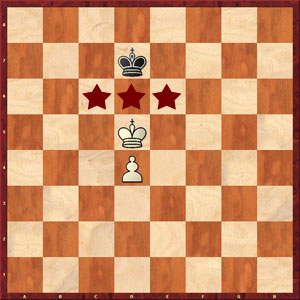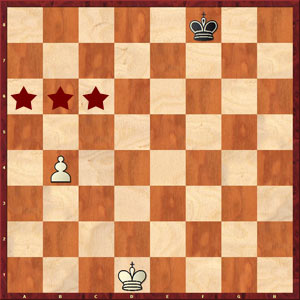Key squares are squares whose occupation by the King assures victory, regardless of whose turn it is to move. (Dvoretsky)

White to move is a draw.
It is important to note that a pawn on the 4th rank or below has 3 key squares, whereas a pawn on the 5th rank or higher has six key squares.

A Pawn on the 5th rank or higher has 6 key squares.
In the example below the key squares are a6, b6 and c6. The key to winning in this position is for the White king to head to the square furthest away from the enemy King (a6), since that square will be the hardest to defend.

1.Kc2! Ke7 2.Kb3 Kd6 3.Ka4 (3.Kc4? Kc6=) 3…Kc6 4.Ka5 Kb7 5.Kb5 +- and Black is in zugzwang.
About the last example.
Note that all the key squares are at the same distance as seen from the white King, but they are at a different distance as seen from the black King.
Glad I found this site-so very interesting. I can’t play- may be my brain is too week or may be I need pre-beginner course (?). And I do not know what is tsug-tsvang. Is it a position when a King, not being under the threat, does not have an option to move? Thank you. G
Zugzwang is when you are forced to make a move, which will give your opponent an advantage usually leading to the gain of material or checkmate. While it can happen at any stage it is most common during the endgame.
In the first diagram, as i understood it is written that white to move leads to adraw, i can see that, the king needs to go back to c4 and guard a pawn, up to d8. I could be mistaken, please explain
I wanted to say that i think white wins:)
First position is standard endgame with white to play draw.If 1.Ke5 Ke7 if 1.Kc5 Kc7=.If 1.Kc4 Kc6 2.d5 Kd6 3.Kd4 Kd7( KEY :if you are forced back go on file of pawn)4.Ke5 Ke7 5.d6 Kd7 6.Kd5 Kd8 7.Kc6 Kc8 8.d7 Kd8 9.Kd6 stalemate draw.
Hello 🙂 I bookmarked this blog. Thanks heaps for this!? if anyone else has anything, it would be much appreciated.
Chess is a good game